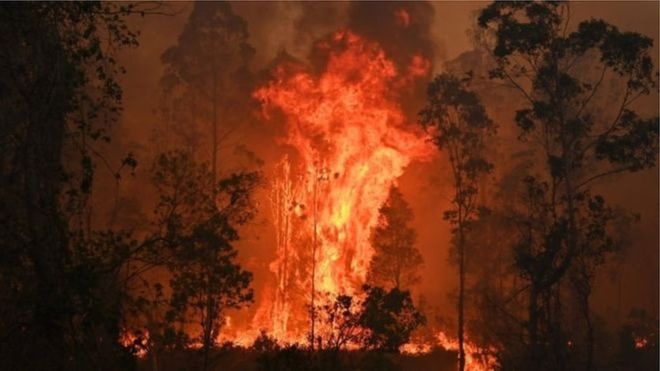
On Saturday, officials feared the death toll would increase on the second day of emergency due to the fire.
Prime Minister Scott Morrison said that at present, about 100 places are on fire and the army can call 1,300 fire personnel to help deal with it.
Hundreds of citizens are also engaged in helping in the affected areas of Queensland and New South Wales.
I express grief to those who lost their lives or lost a member of their family,” Morrison said.
Thousands of people spent the night in empty camps in Queensland. However, officials have said that they can now go home.
Meanwhile, fire officials in New South Wales have confirmed that more than 150 homes have been damaged due to the fire.
Strong wind and 35 degree Celsius served to ignite the fire. Where there is a fire, many of them are located in drought-prone areas.

Who are affected?
On Friday during the sweep of the affected areas, firefighters recovered the body of a man who had been burned in a car near the Glen Inn, about 550 kilometers (340 mi) north of Sidney.
The same day a woman was found in the same city who was severely scorched. He was rushed to the hospital but succumbed shortly after.
A burnt corpse was recovered from a house near Taree, a town about 300 km from Sydney, after which the New South Wales Police confirmed the death of a third person on Saturday.
Police said that the house belonged to a 63-year-old woman but they would not be able to confirm the identity until the postmortem was done.
What’s new?
Shane Fitzsimons, the commissioner of fire service for the New South Wales Rural, said on Saturday that the fire conditions would improve slightly over the next summer or the entire summer months in December and January.
He told the news agency Reuters, “The forecast for the balance of the weather in the coming months will depend on the constant above normal temperature and the average rainfall being low.”

On Friday, there were 17 emergency-level fires across New South Wales at the same time.
However, fire officials said that the drop in temperature, increase in humidity and the help of choppers are helping efforts to combat the fire.
There is a fire about 1,000 kilometers (621 mi) off the coast of Australia.
Some people have been asked to take shelter in the shelter instead of running away from the fire as it is too late to leave the house.
In the most affected New South Wales firefighters have been extinguishing a fire at hundreds of places since last month. However, two people died in an attempt to save their home.
Last week, a 2,000-hectare forest in the Koala Sanctuary caught fire. Hundreds of animals are feared killed in this fire incident.
According to the charity Koala Conservation Australia, more than half the koalas were living in another sanctuary, they may have also been killed due to forest fires.

What is a drought situation?
New South Wales received rains earlier this week, which brought considerable relief to farmers. However, this rain was inadequate to end the long-running drought.
Officials have warned that the fire will continue till there is no more rain.
Fitzsimmons said, “We cannot just exaggerate that there is a fire due to drought.”
Helicopters carrying water often have to travel long distances due to the difficulty in reaching the water in dry areas. In some cases, officials have dug the bore to meet the demand.
Fitzsimons said, “We are very careful about the scarcity of water and it is very expensive. But the reality is that we cannot extinguish a fire without water.”
Last week, a fire broke out in Sydney for a few days due to a fire in Port Macquarie.
A warning has been issued for people with Asthma and other problems of breathing due to poor air quality.

Is it linked to climate change?
According to scientists, due to climate change, the fire season in Australia is getting longer and becoming riskier.
Officials said that they were worried about the severity of the fire before the heat, a year after the record heat in the country.
Officials have confirmed that 2018 and 2017 were the third and fourth warmest years in Australia’s record, respectively.
The Bureau’s State of the Climate 2018 report states that climate change has increased the incidence of extreme heat and the severity of other natural disasters such as drought.
The United Nations said in a report last year that Australia had reduced efforts to cut its CO2 emissions.



